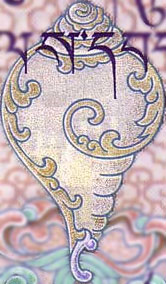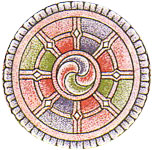 Eight Auspicious Symbols of Bhutan
Eight Auspicious Symbols of Bhutan Eight Auspicious Symbols of Bhutan
Eight Auspicious Symbols of Bhutan
| [ Last Update: Sunday, 17-Jan-2010 14:42:57 EST ] |
dung dkar (White Conch) | |
 | Dung-Dkar translated from Tibetan is literally "White Conch", and true to its name is formed from a white conch shell. It is heavily decorated with ornate patterns with inlaid metals such as bronze and tin and is topped with a bright bead, which is to represent good energy.
The Conch shell has, throughout Indian history, been a symbol of great power, authority and sovereignty. A conch is one of the Ashtamangala, a sacred suite of Eight Auspicious Signs endemic to a number of Dharmic Traditions such as Hinduism, Jainism, Buddhism, and Sikhism. Each mythological hero in ancient Indian epics is described as having a great White Conch shell, which usually has a name. When the hero sounds his White Conch it invokes terror in his opposing forces and symbolises the start of a battle. It is this ancient belief that is thought to have influenced the image of the White Conch in Tibetan music in that the white conch is a sacred symbol of peace and good energy. The dung-dkar has been used as a religious instrument throughout the recorded history of religious music in Tibet. Before Buddhism was introduced to Tibet the religion was the shamanistic "Bon", and the dung-dkar was used to invoke and call the spirits to help grow cattle or food and even banish evil spirits that caused illness and destruction. Nowadays the dung-dkar is mainly found only in Buddhist monasteries and performances, very rarely used as a secular instrument. |
khor lo (Wheel of Dharma) | |
 | After he had attained enlightenment, as a result of requests Buddha rose from meditation and taught the so-called first "Wheel of Dharma." These teachings, which include the Sutra of the Four Noble Truths and other discourses, are the principal source of the Hinayana, or Lesser Vehicle, of Buddhism. Later, Buddha taught the second and third Wheels of Dharma, which include the Perfection of Wisdom Sutras and the Sutra Discriminating the Intention, respectively. These teachings are the source of the Mahayana, or Great Vehicle, of Buddhism.
Buddha's teachings, which are known as "Dharma", are likened to a wheel that moves from country to country in accordance with changing conditions and people's karmic inclinations. The external forms of presenting Buddhism may change as it meets with different cultures and societies, but its essential authenticity is ensured through the continuation of an unbroken lineage of realized practitioners. Buddha's teachings are said to be like a precious wheel because, wherever they spread, the people in that area have the opportunity to control their minds by putting them into practice. |
dpal be'u (Endless Knot) | |
 | The "endless knot" or "eternal knot" represents the inter-twining of wisdom and compassion; represents the mutual dependence of religious doctrine and secular affairs; represents the union of wisdom and method; the inseparability of 'emptinesss' and 'Dependent Co-arrising'; at the time of enlightenment the union of 'wisdom' and 'great compassion'; also symbolic of knot symbolism in linking ancestors and omnipresence and the magical ritual and meta-process of binding, the knot, net and the web metaphor also conveys the Buddhist teaching of the Doctrine of Interpenetration. |